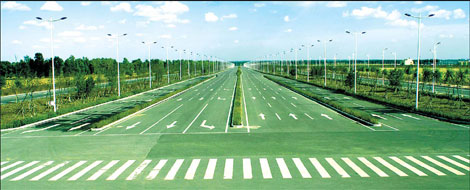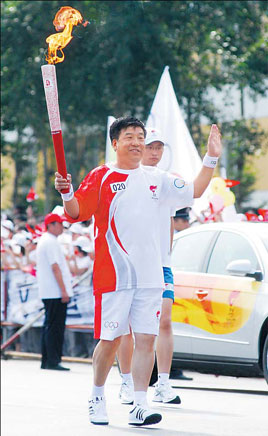Change of mindset brings revitalization
|
Changchun Economic and Technological Development Zone has improved its transportation network. |
Changchun Economic and Technical Development Zone (CETDZ) is known as Changchun's own "Pudong" for its leading position in the provincial capital's economy - a comparison of it to Shanghai's thriving business district.
The capital of northeast China's Jilin province, Changchun is today rapidly developing after decades of upheaval and decline.
Huang Wenhua, director of the CETDZ's administrative committee, attributes the fast economic growth of the zone to a turnaround plan initiated in 2005.
The zone was established in 1993, when various so-called economic zones mushroomed nationwide as the country began to roll out a series of preferential policies to attract foreign capital and investment.
A 30 sq km patch of land in the eastern part of the city was allotted for construction of the zone, which did attract a large group of investors responding to the allure of preferential taxes, abundant and cheap labor, and lower rents.
The policies did work - for a while.
|
Huang Wenhua, director of the administrative committee of CETDZ, with the Olympic torch. |
The influx of foreign capital brought employment and vitality to the zone that was plagued by large layoffs of workers due to a fundamental reform of the city's State-owned enterprises (SOEs) that were on the verge of bankruptcy.
Jilin, a province that was before one of the most important industrial bases in the country, had had its heyday in the 1960s and '70s.
Changchun is termed China's Motown as it is home to State-owned vehicle maker First Auto Works (FAW), which produced China's first sedan.
The planned economy of the period, under which plants produced to meet government commands rather than market demands, landed the province in a quagmire as the country rid itself of backward economic approaches and embraced a market-oriented structure in the late 1970s.
A clumsy transition and backward mindset made it difficult to quickly adjust to new trends, leading to the collapse of the many once-prosperous State-owned plants that were before the backbone of the city's economy.
The result was mergers and restructuring that resulted in huge numbers of dismissed workers.
The establishment of the zone once helped embattled SOEs, as investors with capital and technology created more jobs and spurred growth in the local economy.
But with no distinctive regional and geographic advantages, the zone gradually lost its appeal in the race for foreign investors.
The central government scrapped preferential tax policies for companies in the zone and tightened land use in recent years - the two most important magnets to attract investors.
Blistering development in the zone came to a standstill in 2005, a time described as a hard period, when Huang was appointed to lead the management committee.
It was then that the zone's management knew it was time to find a way out of the plight or remain obscure.
New way out
"The situation was clear, right under our nose," said Huang. "It was a kind of self-confinement to stay within the 30 sq km that we had at that time."
"We needed more space to walk out the dilemma," he said.
A consensus was shortly reached and a blueprint drawn up to enlarge the areas to the east and north.
"The hardest to change was the mindset," Huang said. "Only by shattering the old one could we create a new way out."
Yet Huang and his colleagues were not hasty. After surveys and investigation they finally made up their mind to work out a development plan that streamlined the sprawling development and gave priority to industries that with the biggest potential and sustainability.
"It is at that moment we realized that we should not rush in a blind way," Huang recalled.
A plan to change from only manufacturing to innovation gradually took shape.
They also redefined their own role - away from simply managers to service providers or problem solvers for companies in the zone.
The original 10 special parks within the zone were trimmed and merged into three - automobiles and their parts, corn processing and related chemicals, and modern services.
"There is one thing that we bore clearly in our minds, that is each step we took needed a larger backstop - the support and strength of the city," Huang said.
"Changchun's strengths lie in its solid auto research and production, and the city is one of the country's most important corn producers," he said. "We readjusted the layout to follow."
"Modern services, which provide the most employment and consume the least energy, is the development direction of any city at the moment."
With a clear orientation, a new round of investment poured in.
A series of small and medium-sized auto parts plants sprouted in the southern part of the zone, home to FAW.
A world-class corn processing park grew with the support of Changchun Dacheng Industrial Group Co Ltd, one of the country's leading corn processors.
An improved transport network in the eastern part of the zone - a new sector featuring modern services and hi-tech industries - has further enabled success.
The zone poured in 3.8 billion yuan in 2006 and 2007 to upgrade infrastructure, including building more roads and railways.
Huang said the area has now set a "green threshold" for investment.
"No matter how big the economic benefits are for an investment project, if it fails to pass the environmental evaluation by local environmental bureaus, we can only say sorry to it," he said.
Vitality
It all seems to work. The value of gross industrial output value in the zone rose from 34.7 billion yuan in 2005 to 62 billion yuan in 2007.
In a 2006 appraisal of national economic and technological zones released by the Ministry of Commerce, Changchun's ranking jumped to 15th overall, and to the top of the list of nine such zones in central and northeast China.
Ten mega-projects with a total investment of more than 15 billion yuan found homes in the corn park, which was before 2006 a large expanse of flat ground.
Six plants that have the capability to produce a finished vehicles have introduced 341 products, ranging from whole cars to windshield wipers.
A cluster of small plants that manufacture auto parts for world auto giants like Toyota are now operational in the park.
By 2007, nearly 5,000 companies registered in the zone. Of them 572 are foreign funded, signaling that it has journeyed far from the standstill of just three years ago.
(China Daily 08/08/2008 page40)
















